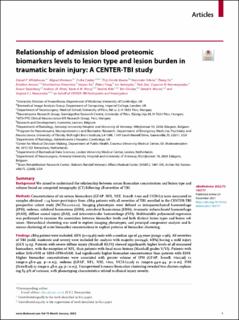| dc.description.abstract | Background
We aimed to understand the relationship between serum biomarker concentration and lesion type and volume found on computed tomography (CT) following all severities of TBI.
Methods
Concentrations of six serum biomarkers (GFAP, NFL, NSE, S100B, t-tau and UCH-L1) were measured in samples obtained <24 hours post-injury from 2869 patients with all severities of TBI, enrolled in the CENTER-TBI prospective cohort study (NCT02210221). Imaging phenotypes were defined as intraparenchymal haemorrhage (IPH), oedema, subdural haematoma (SDH), extradural haematoma (EDH), traumatic subarachnoid haemorrhage (tSAH), diffuse axonal injury (DAI), and intraventricular haemorrhage (IVH). Multivariable polynomial regression was performed to examine the association between biomarker levels and both distinct lesion types and lesion volumes. Hierarchical clustering was used to explore imaging phenotypes; and principal component analysis and k-means clustering of acute biomarker concentrations to explore patterns of biomarker clustering.
Findings
2869 patient were included, 68% (n=1946) male with a median age of 49 years (range 2-96). All severities of TBI (mild, moderate and severe) were included for analysis with majority (n=1946, 68%) having a mild injury (GCS 13-15). Patients with severe diffuse injury (Marshall III/IV) showed significantly higher levels of all measured biomarkers, with the exception of NFL, than patients with focal mass lesions (Marshall grades V/VI). Patients with either DAI+IVH or SDH+IPH+tSAH, had significantly higher biomarker concentrations than patients with EDH. Higher biomarker concentrations were associated with greater volume of IPH (GFAP, S100B, t-tau;adj r2 range:0·48-0·49; p<0·05), oedema (GFAP, NFL, NSE, t-tau, UCH-L1;adj r2 range:0·44-0·44; p<0·01), IVH (S100B;adj r2 range:0.48-0.49; p<0.05), Unsupervised k-means biomarker clustering revealed two clusters explaining 83·9% of variance, with phenotyping characteristics related to clinical injury severity.
Interpretation
Interpretation: Biomarker concentration within 24 hours of TBI is primarily related to severity of injury and intracranial disease burden, rather than pathoanatomical type of injury. | en_US |

